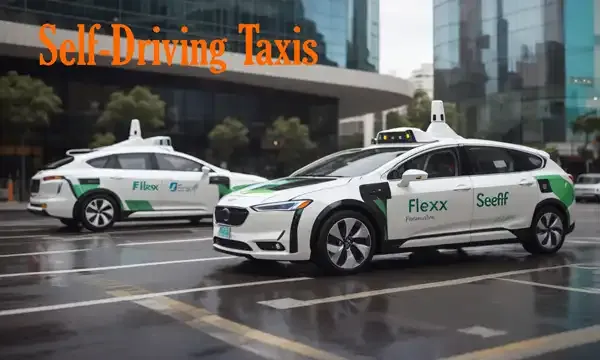Self-Driving Taxis: Pioneering the Future of Transportation
In a world where innovation knows no bounds, self-driving taxis have transitioned from science fiction daydreams to tangible reality. These autonomous marvels are currently undergoing testing in select cities across the globe and hold the transformative power to redefine the way we think about transportation.
In this article, we will delve into the profound implications of self-driving taxis, exploring their potential benefits, the challenges that lie in their path, and the bright future that awaits them.
Benefits of Self-Driving Taxis
Efficiency: Streamlining Urban Mobility
The dawn of self-driving taxis promises a new era of efficiency in urban mobility. These autonomous vehicles can be meticulously programmed to optimize routes, eliminating unnecessary stops and minimizing traffic congestion. As a result, a substantial reduction in pollution and traffic gridlocks could become a reality.
Convenience: A Hassle-Free Commute
Imagine a world where summoning a taxi is as easy as a tap on your smartphone screen. Self-driving taxis offer unparalleled convenience, allowing passengers to hail a ride via an intuitive app. This innovation is particularly impactful for individuals who face mobility challenges, such as the elderly, disabled, or those under the influence, as they can now access transportation with newfound ease.
Affordability: Democratizing Travel
The cost of operating self-driving taxis pales in comparison to their human-driven counterparts. This drastic reduction in operational expenses holds the potential to make transportation more affordable and accessible to individuals across all income levels, reshaping the socioeconomic landscape of commuting.
Challenges on the Road Ahead
Safety: Navigating the Unknown
While the allure of autonomous travel is undeniable, the safety of self-driving taxis remains a paramount concern. These vehicles must demonstrate an impeccable ability to handle diverse road conditions and complex traffic scenarios, ensuring the safety of both passengers and pedestrians.
Regulation: Paving the Legal Pathway
The integration of self-driving taxis into public roads hinges on the establishment of comprehensive regulations. Government bodies must create frameworks that prioritize passenger safety and outline the rights and responsibilities of all parties involved, paving the way for the widespread adoption of this revolutionary mode of transportation.
Public Acceptance: Bridging the Trust Gap
To flourish, self-driving taxis must gain public trust. Overcoming skepticism and reservations surrounding the technology is essential for its success. Building awareness and fostering a sense of security through educational initiatives could play a pivotal role in easing public apprehension.
Technical Challenges: A Precision Dance
The intricate dance between sensors and software that empowers self-driving taxis is a marvel of modern engineering. The development of a highly reliable and accurate system is a critical hurdle to overcome, ensuring seamless navigation and obstacle avoidance.
A Glimpse into the Future
As we peer into the horizon, the future of self-driving taxis holds limitless possibilities:
- Urban Dominance: Self-driving taxis could transform urban landscapes, reigning as the dominant mode of transportation. Their efficient routes and reduced congestion could redefine city living.
- Inclusivity: Providing a lifeline to those who cannot drive, such as the elderly and disabled, self-driving taxis could promote inclusivity and independence.
- On-Demand Economy: Parallel to ride-hailing services, self-driving taxis could offer an on-demand transportation revolution. This accessibility could redefine affordability and convenience.
- Innovative Services: The canvas of innovation is vast, with potential for autonomous carpools and buses. These services could further refine transportation efficiency and environmental impact.
Conclusion: A Roadmap to the Future
In conclusion, self-driving taxis are not merely a futuristic fantasy, but a tangible innovation poised to reshape our transportation landscape. As we've explored the potential benefits, navigated through challenges, and envisioned their role in the days to come, one thing is abundantly clear – self-driving taxis hold immense promise.
While safety, regulation, and public acceptance stand as significant hurdles, the trajectory of self-driving taxis remains promising. These autonomous wonders could usher in a new era of efficiency, accessibility, and affordability in urban mobility.
As the gears of technology continue to turn and societal acceptance deepens, self-driving taxis may well become a familiar presence on our roadways. In doing so, they have the potential to not only change how we move, but also how we think about transportation itself.
We hope this exploration has shed light on the boundless potential of self-driving taxis. If your curiosity is sparked or queries arise, please don't hesitate to share your thoughts – the road to innovation is often paved with questions and conversations.
Frequently Asked Questions
Q1: Are self-driving taxis safer than human-driven taxis?
- Self-driving taxis have the potential to be significantly safer. Their immunity to human errors like distracted or impaired driving could result in a marked reduction in accidents and fatalities.
Q2: How do self-driving taxis navigate the roads?
- Self-driving taxis rely on an array of sensors, including cameras, radar, and LIDAR, to perceive their surroundings. These sensors feed data to a central computer that utilizes artificial intelligence to make real-time driving decisions.
Q3: What role do regulations play in the deployment of self-driving taxis?
- Regulations are pivotal in ensuring the safe integration of self-driving taxis onto public roads. Governments must create comprehensive frameworks to oversee their operations, prioritizing safety and passenger rights.
Q4: Can self-driving taxis adapt to various road conditions?
- Indeed, the success of self-driving taxis hinges on their ability to navigate diverse road conditions, from bustling city streets to rural highways. Their advanced algorithms and sensor suites enable them to adapt effectively.
Q5: Will self-driving taxis replace traditional taxis entirely?
- While the future is uncertain, self-driving taxis could revolutionize transportation by becoming a dominant mode of urban travel. They offer the potential for enhanced efficiency, accessibility, and affordability.


